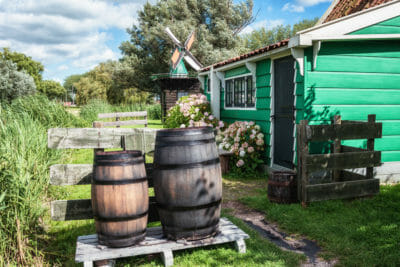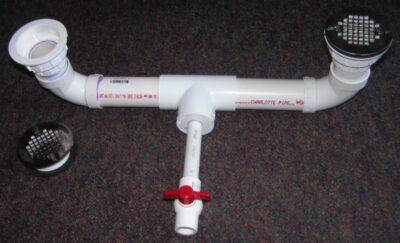
Collecting rainwater through the use of rain barrels can serve to augment your water supply during an emergency.
In olden days, people didn’t know how to build rain barrels for rainwater. However, rainwater has been one of the best sources of water for millennia. Many ancient people groups collected water in man-made or natural cisterns. They counted on that water to nourish their crops, take care of their animals, and get them through dry spells. Some archaeologists have theorized that when the nation of Israel was wandering in the wilderness and needed water, Jehovah directed Moses to strike a rock, which revealed one of these natural cisterns.
Regardless of how you store it, rainwater is some of the purest water you can find. In some parts of the country, it can be one of the most dependable water supplies available. Capturing and storing this water is an excellent way of augmenting your water supplies for emergencies. This procedure will also help to ensure that you will have a steady source of water in those emergencies.
Building a rainwater collection system means having some way of capturing the rainwater itself. This process also entails storing that water once you’ve obtained it. Fortunately, you already have the hardest part of this system, as you already have an existing means of capturing rainwater.
Why You Should Collect Rainwater
Every year, countless gallons of rainwater fall on the roof of your house. How much actually falls depends upon the size of your home and the average annual rainfall where you live. Nevertheless, you are already capturing that rainwater, although you are probably just disposing of it. So, all you need is some way of storing that water, and you’ll have a significant emergency water supply.
If your home has gutters and downspouts, you’re one step closer to having a working rainwater collection system. The rain that is falling on your roof is already collecting itself for you. If you don’t have gutters and downspouts installed on your home, you’ll need to add them. At a minimum, you need to add them for the parts of your roof where you plan to harvest the rainwater.
Hundreds of projects, step-by-step sequences, and illustrations on real Back To Basics skills…
You’ll want all of the rainwater you are collecting to end up going through one downspout, preferably behind your house. For split-level homes or two-story homes with an attached garage, have the water from the upper roof sections drain onto the lower roof section, so that you can collect it as well. However, you might not be able to use your whole roof. This is because usually there’s no convenient way to get the water that is falling on the front of your roof to the back of your house. Nevertheless, whatever water you can harvest will be to your advantage.
If your gutters and downspouts don’t already have screens on them, you should add them. You want the cleanest water you can get, and decaying leaves in the gutters won’t help. If your gutters have been in place for some time, make sure that you clean them out before installing the screens.
An alternate plan is to have multiple collection points. If you have a home with a large roof, this might work out better for you, especially if your roof is broken up into multiple sections. Putting rainwater collectors at both back corners of the house might substantially increase the amount of water you can capture.
How To Build A Collection System
I suppose you could do things like the ancients and build a cistern out of stone or handmade brick, but that’s a lot of work. You’ll accomplish just as much, with a lot less work, by making your rainwater collection system out of a plastic tank or a couple of 55-gallon drums.
Most people use 55-gallon plastic drums for their rainwater collection systems. There are several advantages to this, starting with their low cost, ease of acquisition, and the fact that they won’t rust. You can find a lot of places that sell used drums for very little. If you can get the white drums, those are the best as they probably were used to transport food products; the blue ones, meanwhile, were perhaps used to carry chemicals.
Regardless of the type of barrels you use, you’ll need to make sure that they are as clean as possible. Many chemicals are poisonous, so you want to be sure that you get all of the residue out of them. To clean them effectively, you’ll need to cut out the top, if it isn’t already cut by the company that you buy it from.
You can easily connect multiple rain barrels together for your rainwater collection system, consequently increasing its capacity. How many you end up joining together will depend upon the amount of rain you receive where you live and how much room you can dedicate to rainwater collection. I’ve seen people put as many as four rain barrels together, giving them a capacity of 220 gallons of fresh rainwater.
How To Connect Rain Barrels
You must connect the rain barrels together at the bottom, using standard plumbing fittings. This method both provides a way of allowing the water to flow from one barrel to the next and provides a place to put a valve for getting the water out of the rain barrels.
The most straightforward connection to use at the bottom of the rain barrels is a shower drain. This is not the type of drain that you would use for a combination tub/shower, but this is the type that you would use for a stand-alone plastic shower. These are designed to mount through a hole in plastic material, both sealing off and draining out the water. Most connect to standard two-inch, schedule 40, PVC pipe.
To install the drain in the bottom of the barrel, you will have to cut a hole in it. The actual size of the hole you will need depends upon the drain you buy. I was able to use a 3-1/4 inch hole for mine. Once you cut the hole, the molding ribs on either side of the outside of the hole will need to be ground off to provide a smooth surface for the drain to seal against. While the drain comes with a foam gasket, I found it necessary to replace this with a thicker, harder rubber gasket. I also used silicone under the flange on the outside of the barrel for extra watertight security.
To accommodate the plumbing, you will need to mount the barrels off the ground. You want to mount them high enough so that you can put a five-gallon bucket or five-gallon water jug under the spigot to get the water out. You can make the stand out of anything, but don’t forget to leave room for the plumbing under the barrels.
Assembly

To assemble the plumbing to the barrels, you will first install the drains on both barrels.
To assemble the plumbing to the barrels, you will first install the drains on both barrels. Temporarily place a cap over the drain outlet and partially fill the barrel with water to see if it leaks. Once the plumbing is entirely in place, it is almost impossible to deal with any leaks.
Once your drains don’t leak, you can attach the rest of the plumbing. Instead of using a two-inch ball valve, I adapted my plumbing down to 3/4 of an inch. This size allows me to connect a garden hose or fill a bucket from the cistern. A two-inch ball valve would have been more expensive. In addition, it would have increased the chance of losing all the water on the ground when I opened it too much.
To cap off your barrels, you can cut lids for them out of plywood. There is a lip on the barrel, and it will have a ledge on the inside from cutting out the lid. This location makes a perfect place to put a plywood lid. Keep in mind that your barrel may not be perfectly round, so you may have to trace the opening of the barrel to make a cover that matches it. The lid that is under the downspout needs a 2-inch by 3-inch hole for the downspout to go through. Be sure to paint your lid so that it doesn’t become damaged by water.
But Is It Clean?
While rainwater is considered to be clean, you may not actually have pure rainwater. The rainwater is being harvested off of your roof, meaning that it is running across tar and possibly fiberglass. Besides, birds tend to leave gifts on people’s roofs, which are far from clean. As the water passes through the gutters and downspouts, it may pick up additional garbage, especially if you have old gutters on your house.
If you are going to use your captured rainwater for watering the garden, there’s no problem. However, if you are planning on drinking it, it should always be purified before use. In a survival situation, you never want to trust any water source that you don’t know is pure. These sources would include the rainwater you have collected off your roof.
You may also enjoy reading an additional Off The Grid News article: 4 Proven Methods To Harvest All The Rainwater You Need
Or download our free 30-page report that discusses why clean, safe water could soon be as valuable as oil: Peak Water
Do you have any other suggestions on how to build rain barrels as an emergency water supply? Let us know in the comments below.
Sign up for Off The Grid News’ weekly email and stay informed about the issues important to you
 Off The Grid News Better Ideas For Off The Grid Living
Off The Grid News Better Ideas For Off The Grid Living



